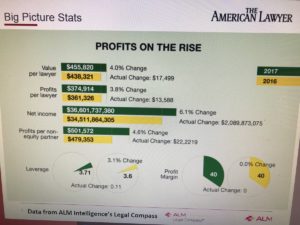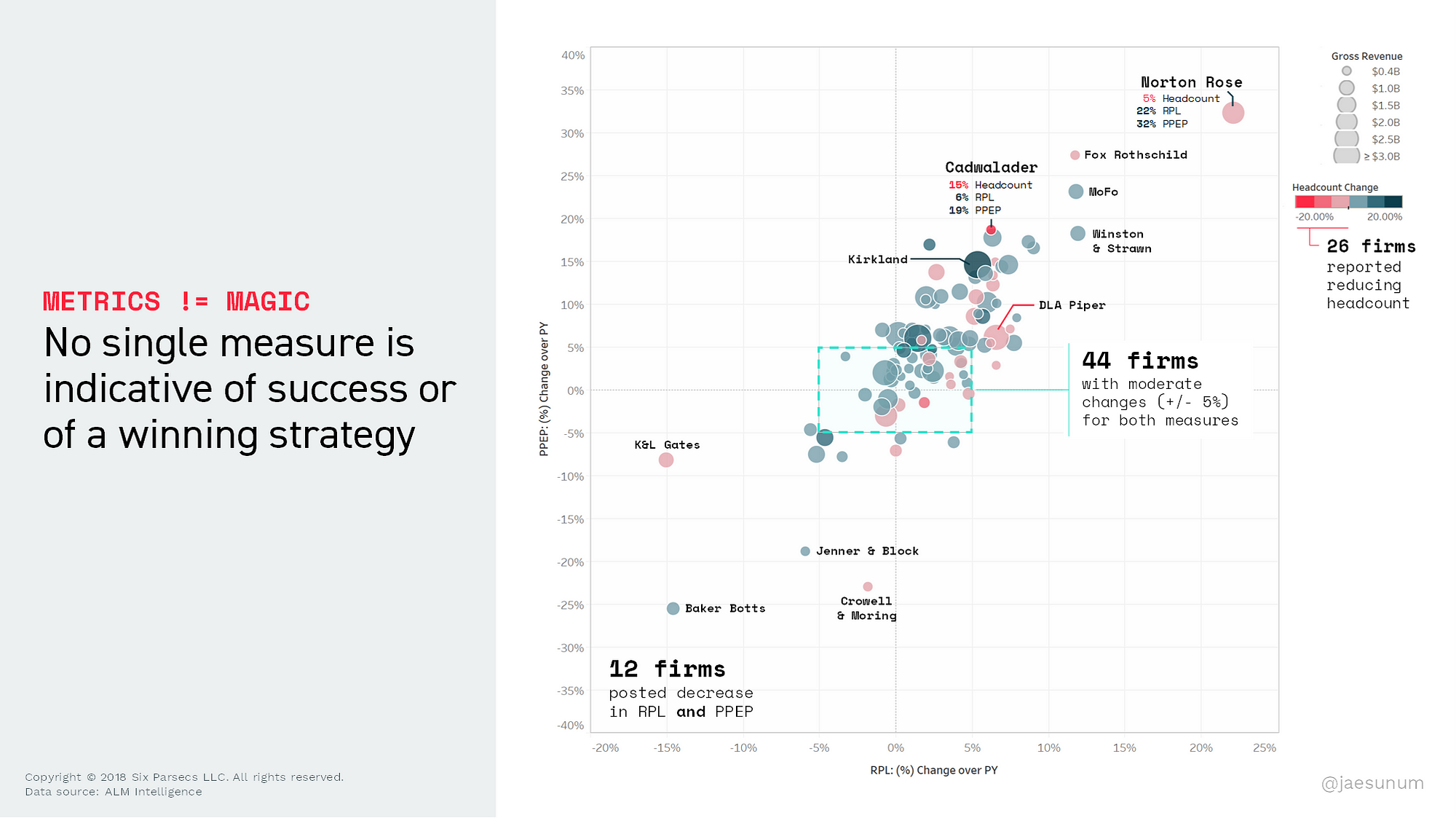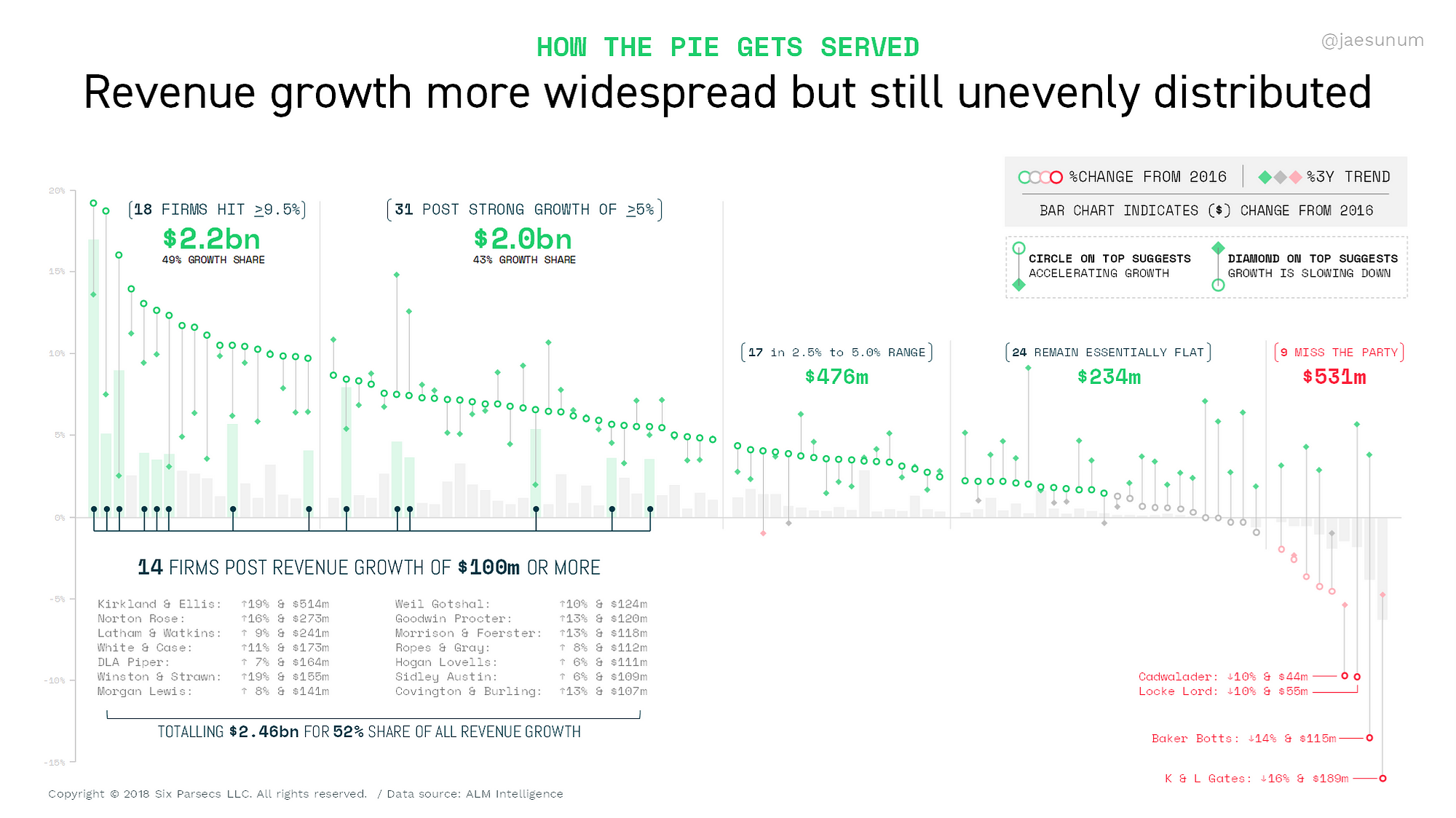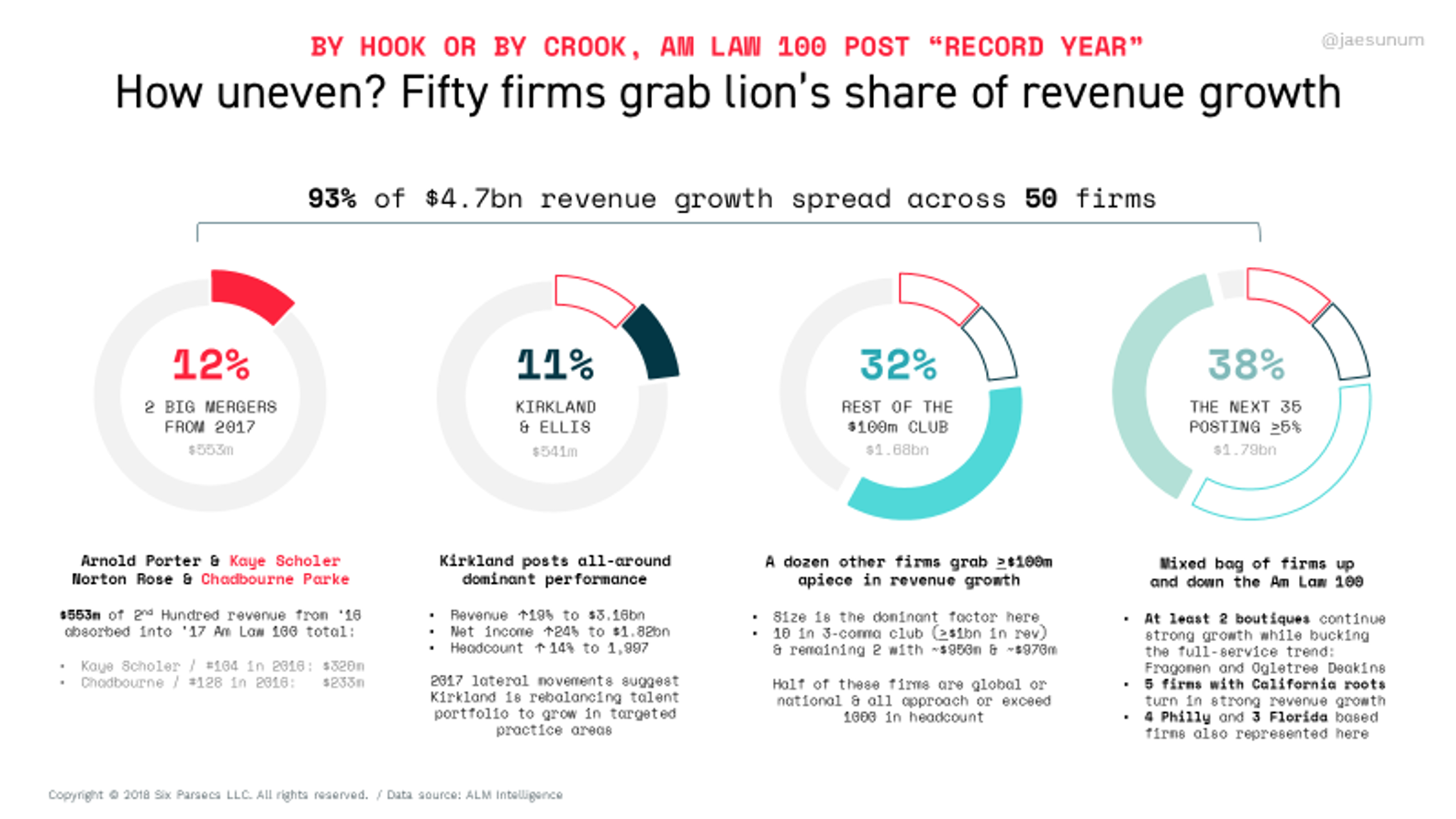From our new contributor, Jae Um: The Empire Strikes Back
With a fresh emoji-backed approach, Jae Um makes her first contribution to Dialogue, The Empire Strikes Back 💥and 2017 Is (Mostly) a 🎉Win 🎉for Am Law 100. Jae says of herself, “I’m generally on a mission to make things make sense and also sparkle. My current tour of duty is data + design to inform strategy in legal markets“. Welcome Jae.
It’s that time of the year! The ALM team have released the “numbers” along with their customary “package” of commentary and analysis on key metrics, which can be found here. I recommend everyone check it out, particularly some of the more in-depth analyses that take a historical look at a longer timeframe.
Amidst ongoing talk of the impending death of BigLaw and some anxiety around overcapacity early in the year, it appears that (most of) the Am Law 100 dug deep to find growth in 2017. In this post, I will be taking a closer look at the revenue growth figures, particularly how they are distributed across the Am Law 100.
Am Law 100 totals and averages look great (especially revenue growth of $4.7bn)
At first blush, the numbers released yesterday by ALM paint a fairly rosy picture for the incumbents. These two slides from a recent ALM webinar make a great snapshot of the topline stats and accompanying headlines:
These are undoubtedly 😄 good numbers… they may even be 😍 great numbers. Certainly, they are some of the ✨ very best 👏 we’ve seen throughout the post-recession recovery.
BUT. Many across BigLaw are not feeling 😍 or even very 😄 — in fact, I see and hear plenty of 😐 and 😒 — so what gives?
Averages are a starting point, not the conclusion: over-reliance can be dangerously misleading
IRL (in real life!) as much on social media, I mention (very) frequently that I am 😞 not 😧 a fan 😠 of averages, particularly when describing or analyzing the legal market. Today I’ll be mentioning that a few more times.
The most important reason that averages are problematic for Big Law is that we are often working with groups that are far from homogenous (whether we are talking about service providers or clients).
This applies, very much, to the Am Law 100. The chart below demonstrates a couple of ways in which this group presents difficulties for would-be analysts. Certainly, an obvious point of interest is the wide range in revenue base: from Kirkland and Latham above the $3bn mark to the last dozen between $350m and $400m. Separating the 100 into 4 groups of roughly equal revenue share brings the disparities into sharper relief (h/t to Roy Strom and the ALM team for the insight): the top 10 highest-grossing firms take roughly as much share as the bottom half of the Am Law 50 or the Am Law 51–100.
Beyond that, though, take a closer look at the level of variance in cost and profit structure not only across the entire 100 but also within each revenue bracket. (For clarity, the bright blue bars represent net income, while the red tick marks indicate net income plus any non-equity partner compensation.) As an example, the 2017 revenue for Norton Rose was just shy of $2bn, with net income of $614m. Compare this to Paul Hastings who pulled in $1.2bn in revenue (~60% of Norton Rose) but posted net income of ~$550m (~90% of Norton Rose).
The tiny green dots at the bottom denote each firm as a member of the 2018 Super Rich: 29 firms that outperform the rest based on revenue per lawyer and profits per lawyer. Mainly, I wanted to point out that these firms are scattered throughout the Am Law 100 — size is neither a prerequisite nor a guarantee of bottom-line dominance.
Before we can get to true insight about who is winning (let alone how to win), we first need to restate some obvious stuff that everyone already knows. The Am Law 100 is a group that includes every manner of organization from single-practice boutiques to full-service globals. The largest firm by lawyer headcount (Baker McKenzie at 4,719) is almost 20x the size of the smallest (Wachtell at 243). We’ve all read plenty about the proliferation of the two-tier partnership, but nearly a fifth of the Am Law 100 still have 0 non-equity partners.
There are many different pathways to profit in the Am Law 100, but not all of those pathways are open to every player.
The headache-inducing truth is this: the ultimate financial performance of these firms varies greatly across and within all of the many subgroups that exist within Big Law. Each firm must face down many tough decisions and make difficult choices: only when those choices add up to a coherent business logic designed for the specific context of each firm will a winning strategy emerge.
Take a longer view: the business of law takes more time than a single calendar year to unfold
The second viz of the day is a bit more involved. This scatter plot / bubble chart displays percentage change over prior year for RPL (horizontal axis) and PPEP (vertical axis). Each circle represents a firm, with the color indicating percent change in headcount. The size of each bubble is the only absolute value used here and provides a rough visual indication of size by revenue.
How should Big Law measure success? Not with any one metric in isolation.
All things being equal, the top right quadrant is where firms would prefer to stay, posting growth in both revenue per lawyer and profit per equity partner. In keeping with the rosy narrative of 2017, a great many firms edged into this quadrant: about 70 out of 100.
While that sounds like cause for much 😄 😄 and 🎉 celebration 🎉 let me add that velocity (speed toward a given direction) is more meaningful than direction alone. In other words, the 44 firms hovering within 5% of the center position on the grid are likely feeling pretty 😑¯\_(ツ)_/¯😐 about the year.
At the other extreme, we only see a handful of firms in the bottom left, with Baker Botts (a member of the Super Rich up until last year) as a something of a surprise, with double-digit decreases in gross revenue as well as RPL and PPEP. Does this portend something ominous for the firm’s future? Possible, but likely not: 2016 was a bona fide banner year for Baker Botts. Buoyed by contingency fees, they posted 20% revenue growth over 2015, along with a truly ridiculous 45% uptick in net income, 18% increase in RPL and 37% increase in PPEP. So Baker Botts in 2017 presents a textbook example of why YOY figures are not the best barometer of a firm’s strategic position or financial health.
Another point of interest is the variation in color (again, indicating percent change in lawyer headcount over 2016). ALM has reported a 2.2% increase across the Am Law 100 for a net gain of 2,112. Surprised by the number and dispersion of pink circles dotting the grid? Try this on for size: in addition to the 26 firms reporting headcount reductions, another 20 or so posted net gain of 10 or fewer lawyers. Put differently, that means nearly half of the Am Law 100 had little or negative contribution toward headcount growth. In fact, only 10 firms account for about half of the 2,112 net gain in lawyer headcount.
The key lesson here? Cast a wider net over coherent sets of metrics and dig deeper through historicals & qualitative context: insights require both experimentation and interpretation.
A final rant on averages. Averages are the definition of abstractions in that average figures do not describe any concrete counterpart in the real world. Here is a ridiculous example: relying solely on averages for any metric in the Am Law 100 is akin to asking for the average age in a given household. These days, my social media feeds are essentially a never-ending stream of baby pictures, so I think the average age for many of my friends’ households would be around 18. I know many young couples with a toddler or two and I literally have zero 18-year olds in my social circles.
Where to focus if not on averages? I say explore first and focus later: distribution is a great starting point
The exploding interest in data visualization is an important trend. At its core, the objective is to democratize data analysis by empowering more people to explore data more freely. And I strongly encourage everyone to take the phrases “exploration” and “visualization” quite literally. Explore data by digging and poking around, and by making pictures from it. Use all the data points. Go wild.
Simple bar charts are the building blocks to distribution analysis (like histograms and other frequency counts). Bar charts (and dot plots) are helpful because they start to reveal important facts about the size and shape of data sets, and they can be built using data points that represent actual concrete things or people rather than abstractions that don’t exist.
The next viz is a bit cluttered, but it conveys a lot of information for the interested viewer. The primary dot plot is a variant of the power curve used above to show the revenue share distribution across the Am Law 100.
This chart, however, focuses on how share of revenue growth is distributed across the Am Law 100. The circles indicate percent change in revenue from 2016, and the firms are sorted left to right (from those with largest revenue gains down to the firms that posted negative change in revenue). However, in the spirit of taking my own advice about looking beyond the YOY figures, I added the 3-year growth rate, represented by smaller diamond marks.
Note here that all 18 of the firms in the first group show the circle on top, suggesting accelerating growth. In the middle 2 groups, there is a mix of circle-on-top or diamond-on-top firms, but as we move toward the right, we begin to see a preponderance of diamond-on-top trends. Aside from just a handful of firms on a strong growth sprint (Kirkland, Fried Frank, Covington, Cozen O’Connor), the vast majority of firms show a trend of regressing toward the mean within a 3- to 5-year window. In other words, revenue growth tends to ebb and flow; this makes logical sense because the majority of firms require some period of stabilization to digest either organic or inorganic growth. (As always, there are exceptions to the rule, particularly among firms with a global footprint who have been managing an ongoing pipeline of inorganic integrations: Dentons, of course, but also DLA Piper and Norton Rose).
I later layered in a bar chart to represent the absolute dollar value of net gain in revenue — this was a necessary step because the Am Law 100 is such a mixed bag of small to huge firms. A revenue growth rate of 6% might sound anemic, but for a firm the size of Hogan Lovells, that 6% uptick represents $111m in revenue growth. Noting that 14 firms posted revenue gains in excess of $100m, I took another tack at slicing up the revenue growth pie.
That leaves just 7% of $4.2bn or around $295m for the other half of the Am Law 100.
The Am Law 100 class from last year largely made it intact into this year’s rankings, with only Pepper Hamilton falling off (presumably into the Second Hundred) & Davis Wright Tremaine climbing 4 spots to #97. The newly tied-up Arnold Porter Kaye Scholer climb into the #36 spot, but that sheds some light on a point we often forget to mention. Both Kaye Scholer and Chadbourne Parke contributed revenue toward the Second Hundred total in 2016 — revenue that is now by and large absorbed into the Am Law 100 total for 2017. While there is no precise way to separate the merger gains in revenue from organically acquired growth, these two deals were sizable enough to account for 12% of the $4.7bn net gain for the entire Am Law 100.
Kirkland deserves its own spotlight here. Although I won’t replicate the many points that have been noted elsewhere in recent weeks, it is quite notable for one firm to post revenue growth of half a billion dollars in a single year.
The other 2 groups (“$100m club” and “next 35”) build on the trends suggested by the growth share dataviz. I did spend a few minutes looking for some discernible patterns across the group of 35 that posted 5% or better revenue growth, but it truly is a mixed bag. (I may return to the hunt in a future post with an eye toward segmentation.)
In short, this view of the 2017 revenue growth takes some of the bloom off the top-line figures. At the same time, I think it’s generally consistent with ALM’s take — as Roy Strom summarized in his big picture narrative, there is some 😟 anxiety 😨 in the air.
For law firm leaders and equity partners picking up the annual rankings to check your PPEP ranking, don’t be lulled into a sense of complacency by the summary stats. As noted above, 5.5% revenue growth and 6.3% PPEP growth — on average — are undoubtedly great numbers. But if your own firm’s numbers were lackluster, know that it’s because one half of the Am Law 100 has grabbed the lion’s share.
Quick hits / other thoughts on Am Law 100
- Some of the broader trends leave me wondering whether the center of gravity in Big Law is shifting — or at least spreading more evenly across New York, Chicago and the West Coast. The New York firms continue to prosper but some of the recent lateral activity also raises questions on whether (and how long) the lockstep firms will be able to defend against Kirkland’s willingness to throw the checkbook around.
- Even on a first pass through the numbers, it’s pretty clear that there’s no magic formula to win in the Am Law 100. Firms within every category and segmentation reported divergent financial results. For instance, among the L&E specialists, Ogletree Deakins roundly outperformed Jackson Lewis and Littler Mendelson. A few global firms posted remarkable revenue growth while others stagnated: that story was consistent for nationals and for regionals. No single category emerged as a bulletproof recipe for growth.
In closing — underneath the benign surface of a record year of recovery, Big Law is facing down a market that is more volatile and uncertain than ever before. All signs in the marketplace suggest that firms investing in focused and smart strategic thinking, as well as the execution capabilities to act decisively, will have a leg up on the competition.
Author
 Jae Um is the Founder and Executive Director of Six Parsecs, a research and insights firm serving the legal vertical. She brings more than a decade of experience in the legal services industry, in diverse roles ranging from legal operations, client service innovation and strategy executive roles within an AmLaw 100 firm.
Jae Um is the Founder and Executive Director of Six Parsecs, a research and insights firm serving the legal vertical. She brings more than a decade of experience in the legal services industry, in diverse roles ranging from legal operations, client service innovation and strategy executive roles within an AmLaw 100 firm.
Connect with Jae on LinkedIn and follow her on Twitter here. Or catch with her for coffee in Chicago.
The Empire Strikes Back 💥and 2017 Is (Mostly) a 🎉Win 🎉for Am Law 100 was first published by Jae in The Medium on April 26, 2018.








Leave a Reply